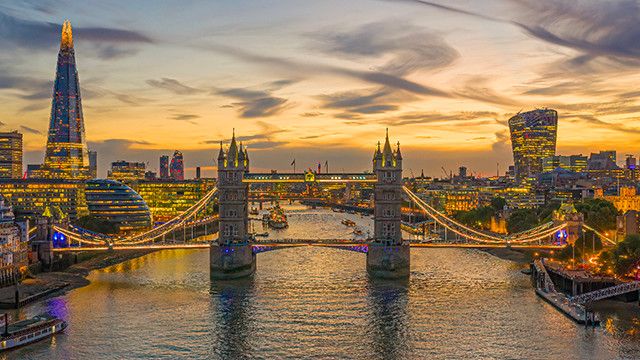The River Thames is the host of the bustling city of London. This metropolitan is the home of the UK’s government and a key financial hub. The city’s advantageous position in the southeast of England has enabled it to thrive, being densely inhabited and prosperous for centuries.
Establishing London
The groundwork for the city of London was laid.
In 43 AD, the Romans established the town of London and maintained their authority until the fifth century, when the Roman Empire fell. During the third century, Londinium, the Roman name for the city, was home to 50,000 citizens, largely due to its major port.
In the fifth century, the decline of the city of Londinium commenced owing to frequent raids by the Anglo-Saxons. By the eighth century, however, it had become the seat of the Essex monarchy.
Anglo-Saxon England experienced a number of Viking raids during the ninth century, leading to the establishment of a Danish presence in the region. This influx of settlers brought about commercial activity in the area, transforming it into the first major urban centre of the time. The town’s prosperity and strategic location eventually caught the attention of the Danish Great Heathen Army, who ultimately laid siege until King Alfred the Great conquered it in 886.
In 1067, England was taken over by the Normans, and William Duke of Normandy was crowned the King of England. The Tower of London was constructed during the rule of William. This was when the rights, laws and privileges of the city were established.
In the year 1199, King John provided additional autonomy to the city, and in 1215, the city’s people were allowed to select a new mayor annually.
For some time, England lacked a capital city. The institutions of the central government were relocated to Westminster near London, a move that was one of the significant contributors to London’s development as the English capital. Furthermore, the increased commerce in the region was another influential element in this process.
Expansion of the City Continues
During the 14th century, London’s port became a European center for the distribution of goods. This was further bolstered during the 15th century due to its significant textile industry.
The Tudors and Stuarts’ centralised politics and maritime trade expansion benefited London from the sixteenth to the mid-seventeenth century. Under Henry VIII’s rule, the city’s population had grown to 100,000. By the mid-seventeenth century, London’s population had ballooned to more than 500,000.
In the year 1665, the city was still surrounded by ancient walls, though large-scale urban planning was already in progress. This was despite the fact that the population’s poverty-stricken living conditions had caused the Great Plague, resulting in the deaths of 70,000 people and the flames of a huge fire consuming most of the city the following year. Based on what is now known as ‘The City’, London’s rebuilding process took more than a decade to finalise. Christopher Wren’s iconic works of art, such as St. Paul’s Cathedral, amplified London’s charm, thus turning it into the social heart of England, with palaces, halls, theatres, societies (Royal Society, 1662) and museums (British Museum, 1753).
The Bank of England, established in 1694, enabled London to expand. After the Swedish Sveriges Riksbank, this second central bank was the most prosperous and provided the financial flexibility that allowed the British Empire’s success to be sustained. This is still apparent today, with London being a global financial hub.
London today is mainly from the Victorian period. Until the first years of the 19th century, the city was limited to the original Roman city, Westminster and Mayfair, bordered by fields. The Industrial Revolution brought millions of people to the capital, causing it to grow. Unfortunately, this overcrowding brought about serious issues such as the 1832 cholera epidemics and the “great stink” of 1858 – a period in the hottest summer months during which the smell of sewage in the River Thames became unbearable, resulting in the suspension of parliamentary sessions.
Between 1750 and 1901, the population of London skyrocketed from 700,000 individuals up to 4,500,000 (6,600,000 if including the outer suburbs). By the close of the nineteenth century, London had evolved into a leading centre for international trade and finance.
In response to the administrative requirements of such a busy urban hub, the County of London was established in 1888 and was governed by the London county council. This county was divided into twenty-nine electoral divisions (including the city and 28 metropolitan boroughs). Nevertheless, the area’s growth extended beyond the county borders and reached into the outlying suburbs. After a period of stability, the capital’s population started to shrink after the conclusion of World War I and dropped below 3.5 million by 1950. In comparison, the suburban region kept increasing steadily.
In 1963, London was divided into the existing town and 32 metropolitan boroughs, which remain the same divisions as can be seen today.
The Withdrawal of the United Kingdom from the European Union
Brexit is an acronym for the withdrawal of the United Kingdom from the European Union, which was completed at the end of January 2020. This process began when the UK voted to leave the EU in a referendum in June 2016.
The UK’s departure from the European Union has been one of the most significant occurrences in London’s recent past. The referendum for leaving the EU was conducted in 2016, but the process of leaving was not completed until 31st January 2020. Following this, a transition period was established to reach a final trade deal, which concluded on 31st December 2020.
The impact of technological advancements on the way we communicate has been immense. The introduction of new communication methods has drastically altered the way people interact with one another. We now have a variety of means of connecting, from text messaging to video calling, that has changed the face of communication. This has enabled us to stay in contact with people from around the world, making it much easier to keep in touch.

